-
A muon anomalous magnetic moment (muon
g−2 ) is experimentally and theoretically analyzed with high precision, and it is a promising observation, to test/verify novel physics beyond the standard model (SM). Recently, the E989 Run 1 experiment at Fermilab (FNAL) [1] provided new data for muong−2 , where the previous measurement at the E821 experiment at Brookhaven National Lab (BNL) two decades ago [2] indicates a deviation from the SM prediction by∼3σ . Combining the BNL results, the deviation from the SM prediction [3, 4] is given byΔaμ=(25.1±5.9)×10−10,

(1) where the deviation reaches
4.2σ with a positive value from the SM prediction. Moreover, a further update of Fermilab E989 and an upcoming J-PARC E34 [5] experiment will provide better results with higher precision. To explain the deviation theoretically, several mechanisms have been proposed over time, such as, gauge contributions [6-8], Yukawa contributions at one-loop level [9], and Barr-Zee contributions [10] at two-loop level. In particular, if muong−2 is related to other phenomenologies such as neutrino mass generations, dark matter, and various flavor physics, the new Yukawa interactions become important, where muong−2 would be explained at a one-loop level via such interactions [9, 11-42] (also refer to recent approaches after new FNAL results [43-78]). In such a case, it is required to simultaneously satisfy several constraints of lepton flavor violations (LFVs), such asℓi→ℓjγ ,ℓi→ℓjℓkˉℓℓ (i,j,k,ℓ=(e,μ,τ) ), including lepton flavor conserving (violating) Z boson decaysZ→ℓˉℓ′ ,Z→νˉν′ [79]. In particular, theℓμ→ℓeγ process presents the most stringent constraint, where the current upper bound on the branching ratio is4.2×10−13 [80], and its future bound will reach the sensitivity at6×10−14 [81]. In addition, Z boson decays will be tested in future experiments such as CEPC [82]. Previously, we analyzed models introducing multi-charged fields (scalars and vector-like leptons) with generalU(1)Y hypercharges, to obtain a positive muong−2 , and explored the parameter region satisfying several experimental constraints [38]. Another interesting study includes a newU(1)′ that explains the same case [83].Another interesting hint for new physics includes experimental anomalies of semileptonic B-meson decays, deviations in the measurements of the angular observable
P′5 in the decay of the B meson (B→K∗μ+μ− ) [84-88], the ratio of branching fractions,RK=BR(B+→K+μ+μ−)/ BR(B+→K+e+e−) [89-91], andRK∗=BR(B→K∗μ+μ−)/ BR(B→K∗e+e−) [92]. Various global fits to corresponding Wilson coefficients are also carried out [93-96], thus indicating that the negative contribution to the Wilson coefficient associated with the(ˉsRγμbL)(ˉμγμμ) operator is preferred in explaining the anomalies. We can explain the anomalies by introducing aU(1)μ−τ gauge symmetry when we include a few extra field contents such as vector-like quarks [97-104].Hence, it is worthwhile to consider a model with multi-charged particles– vector-like quarks, vector-like leptons, and charged scalar fields– under a local
U(1)μ−τ framework, where we can combine the ideas in the model discussed in [38] and [97, 102]. The advantages of this approach are as follows: (1) we can constrain the flavor structure of Yukawa couplings associated with extra fermions, to suppress the constraints from lepton flavor violations (LFVs), (2) we have more contributions to muong−2 from one loop diagrams withZ′ and vector-like leptons, (3) collider signature is controlled by theU(1)μ−τ charge assignment to provide predictions. Subsequently, we investigate if both muong−2 and B-anomalies can be explained simultaneously by analyzing the correlation among the parameters considering experimental constraints, and then discuss collider physics to demonstrate possible signatures of this scenario.In this paper, we discuss the model introducing multi-charged fields (scalars and fermions) under a local
U(1)μ−τ framework, as an extension of the model in [38] and [97, 102]. We investigate contributions to muong−2 from one-loop diagrams, including the new particles such as vector-like lepton, charged scalar, andZ′ boson. Extra vector-like quarks are introduced and Wilson coefficient is calculated to explain B-anomalies. Constraints from meson anti-meson mixing are discussed in addition to LFV and Z decays. Then, we explore the parameter region accommodating both muong−2 and B-anomalies. We search for the parameters satisfying all the constraints, and from the allowed model parameters, we consider the benchmark points (BP's) for the collider study.Because the multi-charged fields can be produced at the Large Hadron Collider (LHC), the signature of the exotic charged particles are also explored. We particularly focus on the LHC signatures of an exotic lepton doublet. Here, the exotic leptons decay
via the charged scalar, which in turn produces different collider signatures w.r.t the standard scenario, where exotic leptons (singly charged) decay into SM particles directly (Wν ,Zℓ , andHℓ ) [105]. We will demonstrate that a small mass difference between the charged scalar and the exotic lepton is naturally favored by the sizable muon (g−2 ). Hence, the collider signature of this particular model will contain very soft muons. We particularly focus on the signature of the two oppositely charged muon and tau pairs at LHC.The remainder of this paper is organized as follows. In Sec. II, we present the setup of the model and formulate the Wilson coefficient for B-decay, meson anti-meson mixing, LFV's, muon
g−2 , and Z boson decays. In Sec. III, we perform numerical analysis to identify the allowed region of parameter space. In Sec. IV, we discuss possible extension of the model by introducing theU(1)μ−τ gauge symmetry and discuss the collider physics signature. We conclude in Sec. V. -
We consider a model with gauge symmetry
GSM×U(1)μ−τ whereGSM is the SM gauge symmetry andU(1)μ−τ is an extra gauge symmetry. In our setup of the model, we introduce isospin doublet fermionsL′a≡ [ψ−a,ψ–a]T(a=1−3) ,Q′a≡[q′−1/3a,q′−4/3a]T≡[u′a,d′a]T and a singly-charged bosons+ , as presented in Table 1①; here x and y forU(1)μ−τ refer to any real number, and the SM quarks are not charged underU(1)μ−τ . For vector-like fermions, we introduce three generations to match with the SM. We also introduce three right-handed neutrinos with theU(1)μ−τ charge. In this paper we do not discuss neutrino mass. Neutrino masses underU(1)μ−τ can be found e.g. in Refs. [106, 107]. Here, we also introduce a scalar field φ with non-zero VEV to breakU(1)μ−τ spontaneously. The Lagrangian involving the interaction of new particles and SM, including the potential, is given by,LLμ 

LLτ 

eRμ 

eRτ 

νRμ 

νRτ 

L′ 

Q′ 

H s+ 

φ SU(3) 

1 

1 

1 

1 

1 

1 

1 

3 

1 

1 

1 

SU(2)L 

2 

2 

1 

1 

1 

1 

2 

2 

2 

1 

1 

U(1)Y 

−12 

−12 

−1 

−1 

0 

0 

−32 

−56 

12 

+1 

0 

U(1)μ−τ 

1 

−1 

1 

−1 

1 

−1 

1+x 

x 0 −x 

y Table 1. Charge assignments of fields under
SU(2)L×U(1)Y×U(1)μ−τ for the extended model. We introduce three generations of vector-like fermionsL′ andQ′ .−LnY=f2aˉLL2L′Ras++giaˉQLiQ′Ras++hijˉLcLi⋅LLjs++kij¯νcRieRjs++MQ′aˉQ′LaQ′Ra+MψaˉL′LaL′Ra+h.c.=f2a[ˉν2PRψ−as++ˉℓ2PRψ−−as+]+gia[ˉuiPRu′as−+ˉdiPRd′as+]+hij[ˉνciPLℓjs+−ˉℓciPLνjs+]+kij¯νcRieLjs++MQ′aˉQ′LaQ′Ra+MψaˉL′LaL′Ra+h.c.,

(2) V=μ2H|H|2+μ2S|s+|2+λH|H|4+λs|s+|4+λHs|H|2|s+|2+μ2φ|φ|2+λφ|φ|4+λHφ|H|2|φ|2+λSφ|s+|2|φ|2,

(3) where
(i,j,a)=1−3 represent generation indices, (⋅≡iσ2 ), withσ2 being the second Pauli matrix, andL′L[R]a(Q′L[R]a)≡PL[R]L′a(Q′a) . The SM Yukawa termyℓiiˉLLieRiH provides masses for charged leptons(mℓi≡yℓiiv/√2 ) by developing a nonzero vacuum expectation value (VEV) of H, which is denoted by⟨H⟩≡v/√2 . The exotic fermion mass eigenvalues are, respectively,MQ′,Mψ for Q', L'. We expect that the interaction term involvinghij plays a role in thes+ decay into SM fields appropriately. However, because this term negatively contributes to the muong−2 , we assume the scale ofhij is not significantly large. This implies that we do not discuss the LFVs and muong−2 of this term. In addition, note that non-zero components ofhij andkij are changed by our choice of parameter x; hence, the decay pattern ofs+ depends on x. More concretely, the structure of the third and fourth terms in Eq. (2) depends on the value of x, such thathijˉLcLi⋅LLjs+=h{12,13}ˉLcL{e,e}⋅LL{μ,τ}s+for x={1,−1},

(4) kij¯νcRieRjs+=k{12(21),13(31),22,33}¯νcR{e(μ),e(τ),μ,τ}eR{μ(e),τ(e),μ,τ}s+for x={1,−1,2,−2},

(5) where we cannot have the Yukawa interaction for
x≠0 . Therefore, the decay pattern ofs+ is determined by the choice of x, where we consider that our right-handed neutrinos are assumed to be light, such thats+ can decay into states containing them. Forx=−2 , the constraint from the collider experiment is weaker becauses± only decays into the third generation of leptons, while we have stronger constraints forx=±1 or2 , because it decays into electrons and/or muons. Hence, we chosex=−2 in our numerical analysis. In addition, we do not have an extra term in any choice of y, wherex≠0 andy≠0 .In a scalar sector, we assume coupling
λHφ is small, such that mixing between φ and H is negligible for simplicity. Under the assumption, the VEV of φ is simply given byvφ≃√−μ2φ/λφ . After φ develops a VEV, we have massiveZ′ boson, whose mass is given bymZ′=yg′vφ,

(6) where
g′ denotes the gauge coupling associated withU(1)μ−τ . The mass eigenvalue ofs+ is given bymS=μ2S+λHs2v2+λSφ2v2φ.

(7) In our numerical analysis, we take
mS as a free parameter. -
The parameter space of our model get constrained from the neutral meson mixings, where the VLQs appear in the loop. The relevant expressions, as presented in [108], are
ΔMQ≈mQf2Q3(4π)2∑3a,b=1Re[gkag∗aigjbg∗bℓ]Fbox(MQ′a,MQ′b,ms),

(8) Fbox(m1,m2,m3)=∫[dx]3zxm21+ym22+zm23,

(9) where
∫[dx]3≡∫10dxdydzδ(1−x−y−z) ,Bs−ˉBs mixing corresponds to(i,j,k,ℓ)=(2,3,3,2) ,Bd−ˉBd mixing corresponds to(i,j,k,ℓ)=(1,3,3,1) , whileK−ˉK andD−ˉD correspond to(i,j,k,ℓ)=(1,2,2,1) . The neutral meson mixing formulas should be lower than the experimental bounds, as given in [108, 109]:ΔmK≲3.48×10−15 [GeV],

(10) 3.29×10−13 [GeV]≲ΔmBd+ΔmSMBd≲3.37×10−13 [GeV],

(11) 1.16×10−11 [GeV]≲ΔmBs+ΔmSMBs≲1.17×10−11 [GeV],

(12) ΔmD≲6.25×10−15 [GeV],

(13) where we have taken the 3σ interval, and
mM andfM are the meson mass and the meson decay constant, respectively. The following values of the parameters are used in our analysis:fK≈0.156 GeV,fBd(Bs)≈0.191(0.274) GeV [110, 111],fD≈0.212 GeV,mK≈0.498 GeV,mBd(Bs)≈ 5.280(5.367) GeV, andmD≈1.865 GeV. The SM contributions are given by [112]:2.96×10−13 [GeV]≲ΔmSMBd≲5.13×10−13 [GeV],

(14) 1.06×10−11 [GeV]≲ΔmSMBs≲1.44×10−11 [GeV].

(15) Subtracting the SM contributions from the experimental results, the following bounds can be obtained:
−1.85×10−13 [GeV]≲ΔmBd≲4.05×10−14 [GeV],

(16) −2.77×10−12 [GeV]≲ΔmBs≲1.07×10−12 [GeV].

(17) -
In our model, we apply the same mechanism in [97, 102] to generate
ΔCμ9 usingZ′ interaction; other mechanisms withU(1)μ−τ can be found in [103, 104]. We obtain the contribution toΔCμ9 from diagrams in Fig. 1. Subsequently, we obtain the contribution toΔCμ,Z′9 as in [97, 102]ΔCμ,Z′9≃xg′2(4π)2m2Z′CSM3∑a=1g3ag∗a2×∫[dx]2ln(Δ[MQ′a,mS]Δ[mS,MQ′a]+M2Q′axm2S+yM2Q′a),CSM≡VtbV∗tsGFαem√2π,Δ[m1,m2]=xm21+ym22,

(18) where
∫[dx]2≡∫10dxdyδ(1−x−y) and quark masses are ignored. We can obtainΔCμ,Z′9∼−1 satisfying all the experimental constraints as shown in [97, 102] withMQ′a=O(1) TeV,mS=O(100) GeV andmZ′=O(100) GeV, whereZ′ contribution to muong−2 is negligible in this region.Here, we simplify the above formula by carrying out an integration
ΔCμ,Z′9≃∑ag3ag∗a2xg′22(4π)2m2Z′CSM.

(19) In addition, we also obtain an Effective Lagrangian to induce
b→sℓˉℓ decayvia box diagram, such thatL[box]=−∑a,bg2ag∗a3f2bf∗b24(4π)2(ˉsγμPLb)×(ˉℓ2γμℓ2−ˉℓ2γμγ5ℓ2)Fbox(MQ′a,Mψb,ms),

(20) which corresponds to
O9=−O10 [93].ΔCμ[box]9=−ΔCμ[box]10≈∑a,bg2ag∗a3f2bf∗b24(4π)2CSMFbox(MQ′a,Mψb,ms),

(21) where
CSM≡VtbV∗tsGFαem√2π . In total, we obtain the new physics contribution to the Wilson coefficient,ΔCℓ9 , asΔCμ9=ΔCμ,Z′9+ΔCμ[box]9.

(22) Furthermore, we should consider the diagrams replacing
Z′ by Z in Fig. 1, which induce flavor universal contributions toC9 andC10 via the Z boson exchange. Calculating the diagrams, we obtainΔC9(Z)≃∑ag3ag∗a2g224(4π)2m2Zc2WCSM×(−12+43s2W)(−12+2s2W),

(23) ΔC10(Z)≃∑ag3ag∗a2g228(4π)2m2Zc2WCSM(−12+43s2W),

(24) where
cW=cosθW , withθW being the Weinberg angle. Because structures ofC9,10(Z) are similar toΔCμ,Z′9 , we obtain the relationshipΔC9(Z)ΔCμ,Z′9≃g22m2Zc2Wm2Z′xg′212(−12+43s2W)(−12+2s2W),

(25) ΔC10(Z)ΔCμ,Z′9≃g22m2Zc2Wm2Z′xg′214(−12+43s2W).

(26) Then, the
b→sμˉμ anomalies can be explained byΔCμ,Z′9=−0.97 as the best fit value,[−1.12,−0.81] at 1σ, and[−1.27,−0.65] at the 2σ interval [96]. The flavor universalΔC9(Z) is significantly smaller thanΔCμ,Z′9 , owing to the suppression factor(−1/2+2s2W) . ForΔC10(Z) , we consider constraint from theBs→μ+μ− measurement. Recent LHCb measurement of the branching ratio is given by [113, 114]BR(B0s→μ+μ−)exp=(3.09+0.46+0.15−0.43−0.11)×10−9,

(27) where the first uncertainty is statistical and the second one is systematic. We can estimate the branching ratio in the model, such that [115]
BR(B0s→μ+μ−)th=|1−0.24ΔCμμ10|2BR(B0s→μ+μ−)SM,

(28) where
BR(B0s→μ+μ−)SM=(3.65±0.23)×10−9 is the theoretical predication in the SM [116]. In the numerical analysis, we impose that the branching ratio in our model is within the1σ region in Eq. (27). In addition, note thatx<0 is preferred because we realize a positiveC10 to fit the data. -
In our model, we do not have lepton flavor violations from Yukawa coupling
fia because only components associated with muon,f2a , are non-zero. Hence, we only focus on the contribution to muong−2 from the Yukawa interactions.The muon anomalous magnetic moment (
Δaμ ): We can estimate the scalar loop contribution to the muon anomalous magnetic moment via (muong−2 ), which is given byΔaSμ≈−mμ(aL+aR)22.

(29) The amplitude
aL/R can be expressed as,(aL)22≈(aR)22≈−mμ∑a=1−3f2af∗a2(4π)2×[F(Mψ−−a,mS)+2F(mS,Mψ−−a)],

(30) where
Mψ−−≡Mψ .It is worthwhile considering
Δaμ via Z′ , although it would not be required because we already have the contributionvia f2a , and the preferred mass range is lighter than that for the B anomalies. TheZ′ boson loop contribution is obtained as [117]ΔaZ′μ=g′2m2μ4π2∫10dxx2(1−x)x2m2μ+(1−x)m2Z′.

(31) In summary, muon
g−2 is given byΔaμ=ΔaSμ+ΔaZ′μ.

(32) The measured value exhibit a
3.3σ deviation from the SM prediction, given byΔaμ=(26.1±8)×10−10 [3], which is also a positive value. Note here that the charged scalar contribution usingh23 is negligible, as we considerh23 to be small, as discussed below Eq. (3). -
Here, we consider the Z boson decay into two leptons using the Yukawa terms involving
f2a at one-loop level [25]. Because some components off2a are expected to be large, to obtain a sizableΔaμ value, the experimental bounds on Z boson decays could be an issue at the one-loop level. Note that Z boson decays are modified only when the second generation of leptons are involved due to theU(1)μ−τ symmetry. This is why we consider the flavor conserving processes of Z boson only.First, the relevant Lagrangian is given by③
L∼g2cw[ˉℓγμ(−12PL+s2W)ℓ+12ˉνγμPLν]Zμ+g2cw[(−12PL+s2W)ˉψ+γμψ−+(−12PL+2s2W)ˉψ++γμψ−−]Zμ+ig2s2WcW(s+∂μs−−s−∂μs+)Zμ,

(33) where
s(c)W≡sin(cos)θW∼0.23 represents the sine (cosine) of the Weinberg angle. The decay rate of the SM at tree level is then given byΓ(Z→ℓ−iℓ+j)SM≈mZ12πg22c2W(s4W−s2W2+18)δij,

(34) Γ(Z→νiˉνj)SM≈mZ96πg22c2Wδij.

(35) Combining all the diagrams in Fig. 2, the ultraviolet divergence cancels out and only the finite part remains [25] and is given by,
ΔΓ(Z→μ−μ+)≈mZ12πg22c2W[|Bℓ22|22−Re[A22(Bℓ)∗22]−(−s2W2+18)],

(36) ΔΓ(Z→νμˉνμ)≈mZ24πg22c2W[|Bν22|2−14],

(37) where,
A22≈s2W,Bℓ22≈12−∑af2af†a2(4π)2Gℓ(Mψa,mS),Bν22≈12+∑af2af†a2(4π)2Gν(Mψa,mS),

(38) Gℓ(Mψa,mS)≈−s2W(−12+s2w)H1(Mψa,mS)−(−12+s2w)2H2(mψa,mS)+(−12+2s2w)H3(Mψa,mS),

(39) Gν(Mψa,mS)≈−s2W(−12+s2w)H1(Mψa,mS)−12H2(Mψa,mS)+(−12+s2w)H3(Mψa,mS),

(40) H1(m1,m2)=m41−m42+4m21m22ln[m2m1]2(m21−m22)2,

(41) H2(m1,m2)=m42−4m21m22+3m41−4m22(m22−2m21)ln[m2]−4m41ln[m1]4(m21−m22)2,

(42) H3(m1,m2)=m21(m21−m22+2m22ln[m2m1](m21−m22)2).

(43) Notice here that the upper indices of B and G;
ℓ,ν , respectively, represent pairs of the muon and muon-neutrino final states. We consider ψ asψ−− inside the argument ofGℓ , while ψ asψ− inside the argument forGν . The current bounds on the lepton-flavor-(conserving) changing Z boson decay branching ratios at 95 % CL are given by [79]:ΔBR(Z→Invisible)≈∑i,j=1−3ΔBR(Z→νiˉνj)<±5.5×10−4,

(44) ΔBR(Z→μ±μ∓)<±6.6×10−5,

(45) where
ΔBR(Z→fiˉfj) (i=j ) is defined byΔBR(Z→fiˉfj)≈Γ(Z→fiˉfj)−Γ(Z→fiˉfj)SMΓtotZ,

(46) where the total Z decay width
ΓtotZ=2.4952±0.0023 GeV [79]. We consider all these constraints in the numerical analysis in the next section. -
Here, we discuss the experimental constraints for the gauge interaction associated with
Z′ . The gauge coupling andZ′ mass are restricted by the neutrino trident processνN→νNμ+μ− , where N is a nucleon [6, 118]. The approximated bound is given bymZ′/g′≳550 GeV formZ′>1 GeV, and we apply the bound in our numerical analysis below.The gauge interaction is also constrained by the LHC experiment searching for the signal of
pp→μ+μ−Z′ (→μ+μ−) , as given in [119]. The experimental results put the constraint on a new gauge coupling, in the mass range5≲mZ′≲70 GeV. We will compare parameter region, explaining B anomalies with the constraint. -
Finally, we discuss the decay of charged scalar that provides implication to collider physics when we introduce
U(1)μ−τ symmetry. As discussed below, Eq. (2) charged scalar decays into only the third generation of leptons when we chosex=−2 . We then chosex=−2 to relax the collider constraint from the charged scalar signature. The decay width ofs+ forx=−2 is given byΓs±→τ±RνRτ≃k23316πmS,

(47) where we ignored the lepton mass in the final state assuming light right-handed neutrino. In addition, we assume right-handed neutrinos are long-lived and it will be just missing energy at collider experiments. Furthermore, note that the lightest particle among
Q′ ,L′ , ands+ would be stable when there is no interaction associated withhij orkij in other choices of x value. -
In this section, we perform a numerical analysis to search for parameter sets that accommodate all the phenomena discussed above. Here, we scan our relevant free parameters
{gia,f2a,g′,mZ′,Mψa,MQa,mS} globally in the following range:gia∈[10−5,1],f2a∈[10−2,1],g′∈[10−3,1],mZ′∈[10,1000] GeV,Mψ1∈[100,500] GeV,Mψ2∈[Mψ1,750] GeV,Mψ3∈[Mψ2,1000] GeV,MQ′1∈[1000,5000] GeV,MQ′2∈[MQ′1,5000] GeV,MQ′3∈[MQ′2,5000] GeV,mS∈[Mψ1−20,Mψ1−10] GeV,

(48) where we also chose
x=−2 for theU(1)μ−τ charge assignment. Here, we choseMψ1 andmS values to be nearly degenerated to avoid constraints from the heavy-charged lepton search at collider experiments. We find thatb→sμˉμ and the neutral meson mixing mainly depends on following Yukawa coupling combinations:Cμ9∼g21g∗13|f21|2,ΔmK∼g21g∗11,ΔmBs∼g31g∗12,ΔmBd∼g31g∗11,ΔmD∼g11g∗12.

(49) Because we would like to increase
Cμ9 to as large as possible, while all the meson mixings should be within the experimental ranges, the following hierarchy is preferredg11<<g21≲g31.

(50) Then, we estimate
Cμ9 and muong−2 imposing experimental constraints. In Fig. 3 we present the allowed parameter space in terms ofmZ′ andg′ to explain theb→sμˉμ anomaliesvia ΔCZ′9 within the1σ region of global fit. We also present the parameter region excluded by the LHC measurement searching forpp→μˉμZ′(→μˉμ) process [119]. We determine that the parameter region ofmZ′≲50 GeV is excluded by the LHC constraints while heavierZ′ region can accommodate the B anomalies. For the allowed region, the upper limit ofg′ for fixedmZ′ is determined by the constraint from the neutrino trident while the lower limit is given by constraint fromBR(B0s→μ+μ−) . Consequently, we determine the narrow range of parameter space where the region close to the neutrino trident limitmZ′/g′>550 is allowed. Note that the maximum|Cμ[box]9| is 0.115 at most, which is out of the 3σ range of experimental results due to the stringent constraint emerging fromΔmBs , because they (ΔCμ[box]9 andΔmBs ) are proportional to the same combinationg31g21 . If one extendsgai to be complex, then one can evade the constraint ofΔmBs and keep large value of|ΔCμ9| . However, in this case, another experimental bound of CP asymmetryACP arises and it gives more stringent constraint [120]. Therefore, we need the contribution fromZ′ interaction to explain B anomalies.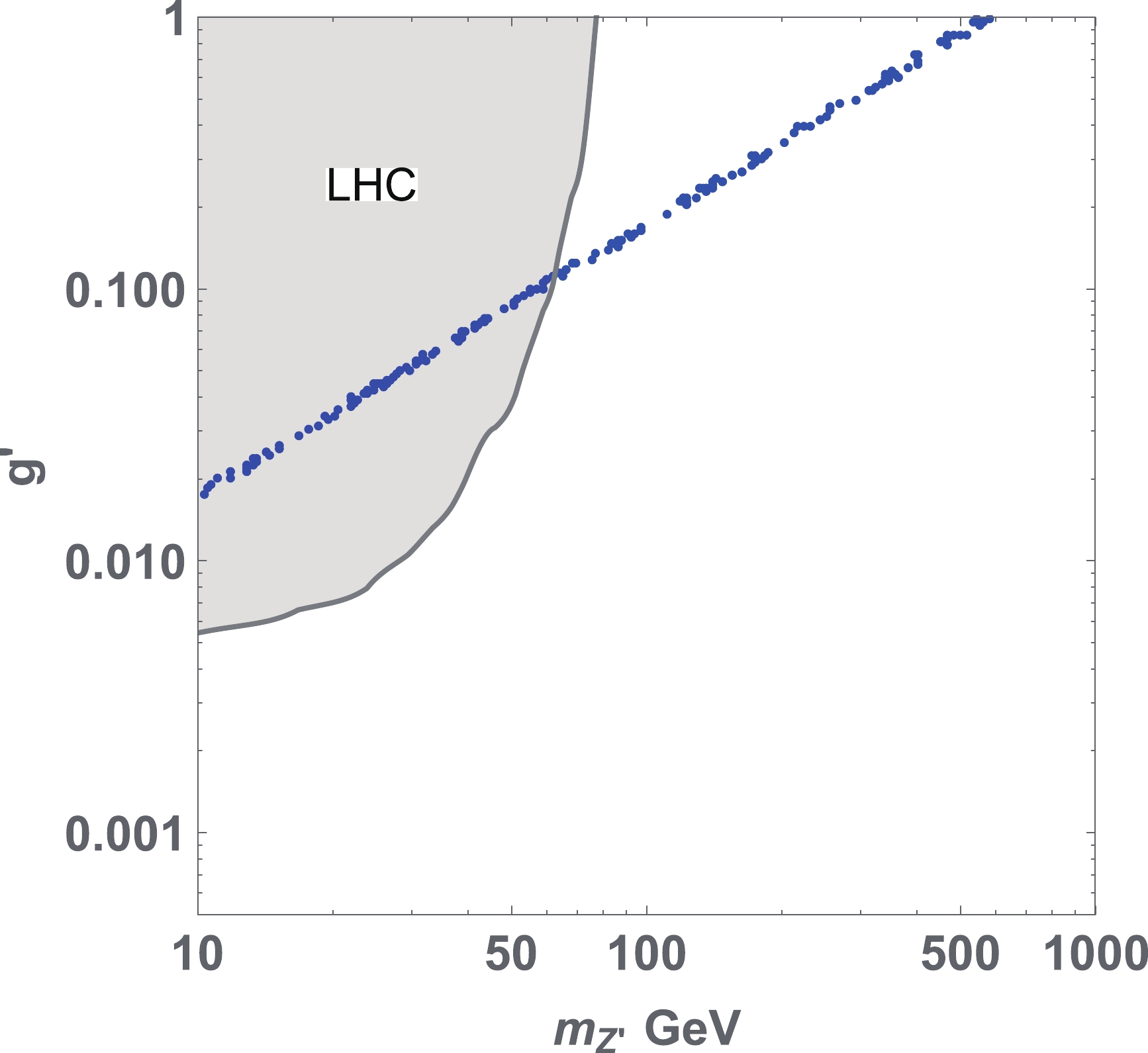
Figure 3. (color online) Allowed points in the parameter space of
mZ′ andg′ that can explain the anomaly ofb→sμˉμ , providingΔC9 within 1σ interval of global fit. We also present the region excluded by thepp→μ+μ−Z′(→μ+μ−) search at the LHC experiment.Next, we show muon
g−2 for allowed parameter sets satisfying all experimental constraints and explaining the B anomalies. In the left(center) plot of Fig. 4, we present the contribution to muong−2 from the scalar (Z′ ) loop as a function ofMψ1(mZ′) , and the total muong−2 is shown in the right plot of the figure. We find that the contribution from theZ′ loop can be larger than2×10−10 formZ′≲600 GeV. Note here that the upper bound up to600 GeV comes frommZ′/g′>550 GeV while that above600 GeV comes from our choice ofg′<1 . The contribution from the scalar loop can be larger than10−10 formψ1≲260 GeV. In particular, it can be close to10−9 formψ1∼100 GeV region. It is thus possible to explain muong−2 within the2σ level when we add bothZ′ and scalar contributions for lightmψ1 region. We also note that the upper bound onf21 is∼0.6 , which restricts the maximum value ofΔaSμ . Here, this upper bound off21 originates from the constraints of Z boson decays.
Figure 4. (color online) Left : Contribution to muon
g−2 from scalar loop diagrams. Center : Contribution to muong−2 from theZ′ loop diagram. Right: Sum of scalar andZ′ contributions. The regions between solid, dashed, and dotted lines indicate the 1 σ, 2 σ, and 3 σ regions of deviation between the observed value and SM prediction respectively. -
As discussed in the previous subsections, to get sizable muon
g−2 that satisfies the flavor constraints together, the mass scale (M) of the exotic lepton doublet is required to be light; to obtainΔaSμ≳O(10−10) we needM≲300 GeV. Here, we are interested in the production and decay modes of the doubly charged vector like lepton (VLL) given by,pp→ψ++ψ−−,ψ++→(μ+s+)→μ+(νll+),ψ−−→(μ−s−)→μ−(ˉνll−).

Hence, the final state is 1 oppositely charged muon pair + 1 oppositely charged lepton (l) + MET. Because we choose
f21=0.5 ,ψ±± will decay mostly in to muon and a charged scalar. Now the coupling of the charged scalar with the SM lepton and neutrino is defined byk33 , as discussed in Sec. II.F, and we consider it to be of the order 0.01 wheres+ decays intoτ+ˉνRτ with 100 % branching ratio.Vector-like leptons and quarks are constrained from the collider physics experiments. The ATLAS Collaboration performed a search for heavy lepton resonances decaying into a Z boson and a lepton in a multi lepton final state at a center-of-mass energy of 8 TeV [121], constraining the singlet VLL model and excluding its mass range of 114 – 176 GeV. For the doublet VLL model, the L3 Collaboration at LEP placed a lower bound of
∼ 100 GeV on additional heavy leptons [122]. It has been demonstrated in [105] and [123] that the VLL's in the mass range 120 – 740 GeV are excluded with 95% CL in different multilepton signals. In these analyses, the vectorlike leptons were singly charged and hence it only decays to a SM boson (H, W, Z) and SM leptons. However, in our case, VLLs decay in to a charged scalar and muon specifically, followed by the decay of the off-shell or on-shell charged scalar into a neutrino and another τ lepton. Here, we assume thatMψ∼mS and the produced muon is less energetic, which would be missed at detectors by the kinematical cut. Hence, the characteristic of our signal is significantly different from [105] and [123]. Similarly, for vectorlike quarks, the current limit is 1–1.3 TeV [124], but in our model, it decaysvia the charged scalar, thereby resulting in different final states not searched so far at LHC.LEP experiment excludes the charged Higgs masses below 80 GeV [125]. At the LHC, searches for the charged Higgs have been performed through various decay channels,
H±→cs [126],tb [127] andντ± [128], and most of these searches excludem±H<mt . Other searches such as that of [128] give upper limit on the cross section× BR as a function of the charged scalar mass. Notice that thes± only pair produced via theZ/γ propagator in thes− channel and the cross section is below the current limit.In this analysis, we made our selections differently from [105] and [123]. As a negligible mass difference between the charged Higgs and the VLL naturally implied from the muon (
g−2 ), the muon will have a very smallpT(∼10 ) GeV, but the other two leptons will have a much higherpT . Other two leptons are τ in our case because we chose theU(1)μ−τ charge, such as charged scalar couples only τ and τ-neutrino. This scenario is still allowed for the VLL mass≤300 GeV. There are scenarios [129, 130] when the doubly charged VLLs decay to aW± and lepton(l± ), giving a final state of two oppositely charged lepton pair (l± ) + MET. In this study we have focused on a more exotic scenario, as proposed by theU(1)μ−τ extended model, where the charged exotic leptons decays to tau lepton and a neutrinovia the charged scalar. Hence, in this study, we select our signal to be 1 oppositely charged muon pair with very small pT + 1 oppositely charged tau pair with a moderate pT + MET, and we keep the mass difference between the charged Higgs and the VLL∼ 10 GeV. The same final state has also been studied for a more general model of vector-like leptons in [131]. One of the advantages of VLL with small mass is that the cross section is large, which can negate the effect of the suppression due to more than one tau tagging. Moreover, in the VLL signatures studied so far by CMS and ATLAS, the assumption was that VLL decays to a W or Z, which is unlikely in our case. Consequently, theW/Z veto can increase the signal efficiency.We express the model Lagrangian of Eq. (2) in FeynRules (v2.3.13) [132, 133]. We generate the model file for MadGraph5_aMC@NLO (v2.2.1) [134] using FeynRules. Then, we calculate the production cross section using the NNPDF23LO1 parton distributions [135] with the factorization and renormalization scales at the central
m2T scale after thekT -clustering of the event. We have computed the signal cross section ofpp→ψ++ψ– , wherep=q,ˉq,γ . The cross sections are normalized to the 5-flavor scheme. The inclusion of the photon PDF increases the signal cross section significantly, as the coupling is proportional to the charge of the fermion. We plot the the production cross section in Fig. 5 for 13 TeV, as well as 27 TeV. Production cross sectionpp→s+s− is much smaller than that ofψ++ψ−− and mass regionM(mS)<150 GeV is still allowed by current experimental constraint [128]. After showering events in PYTHIA [136], events were passed through DELPHES 3 [137] for the detector simulation. In DELPHES, we choose the isolation cut for leptons to be\Delta R_\max} = 0.5 , to ensure no hadronic activity inside this isolation cone. While generating the events, we kept the minpT for muons to be 6 GeV, and also follow other trigger requirements for the soft muons following [138]. The tau tagging efficiency is considered to be 0.6, and the misidentification efficiency is 0.01.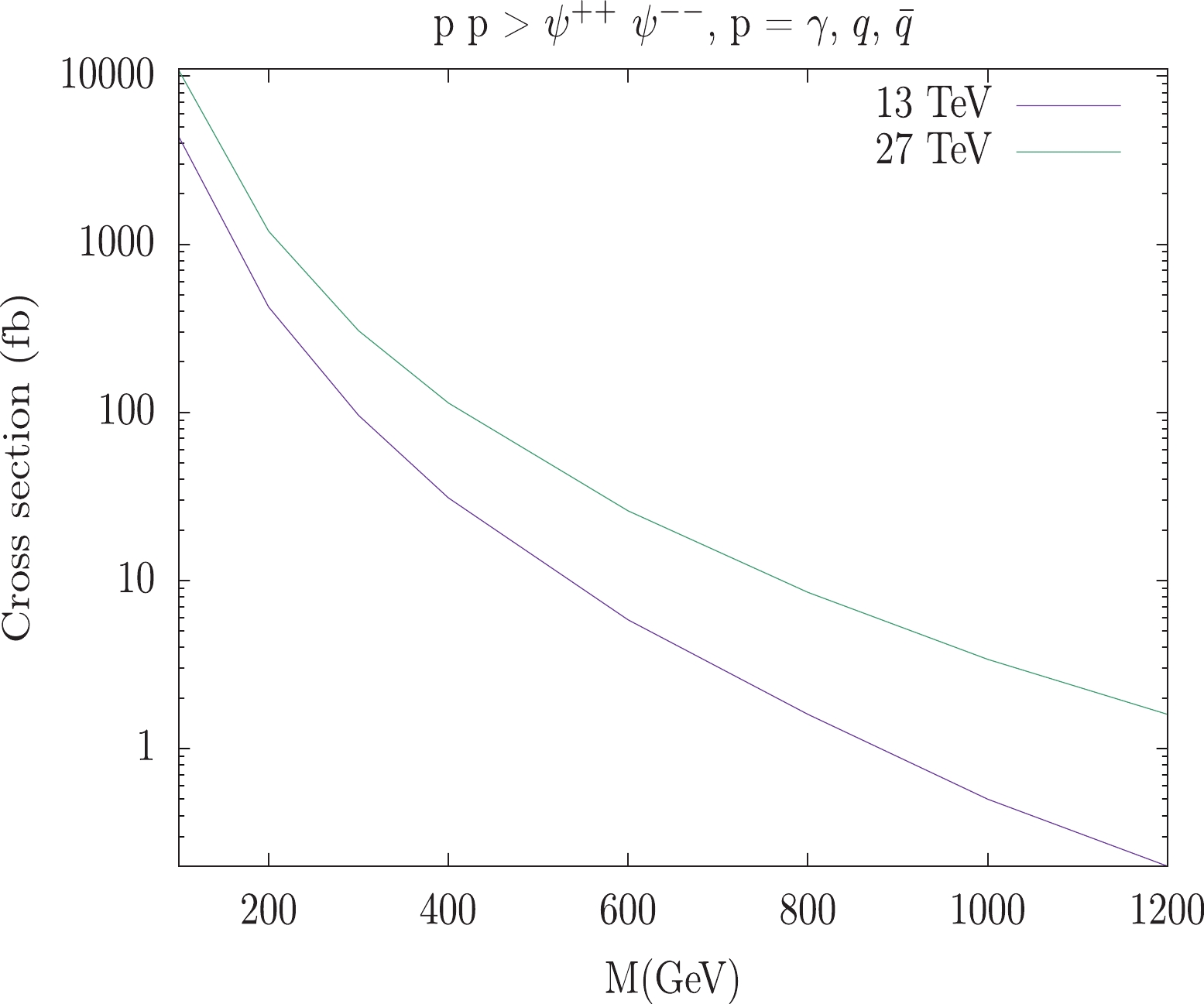
Figure 5. (color online) The cross section for the pair production process
pp→ψ++ψ−− as a function of the VLL mass at 13 TeV and 27 TeV.The
pT distribution of the leading and subleading tau and muon is presented in Fig. 6 for BP1. In Fig. 7 (left), we present the transverse missing energy andHT(l)=∑ipT(l)i distribution and (right) the ratioMET/meff (meff=ET+HT(l)+HT(j) ), which is effective to reduce the QCD-jet backgrounds. Based on these distributions we select a set of simple cuts on different kinematic variables.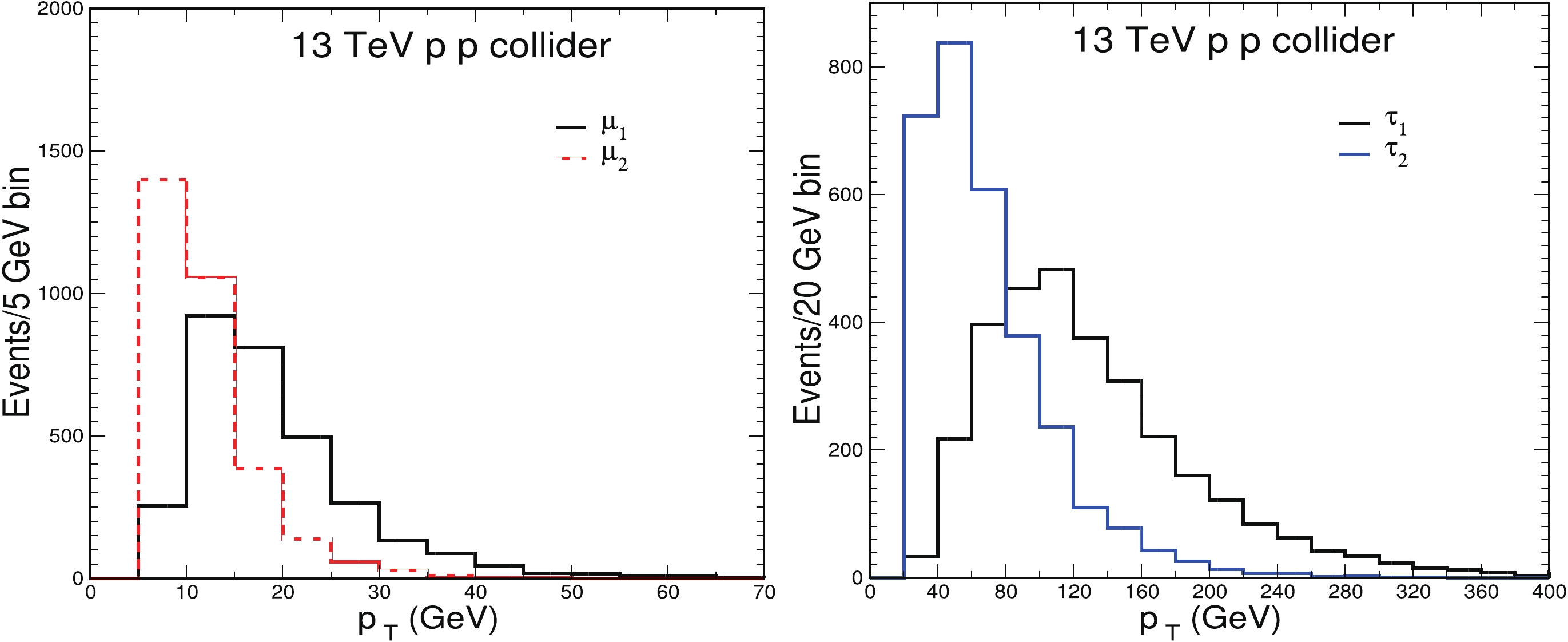
Figure 6. (color online) The transverse momentum distribution of the leading(1) and the subleading(2) muon (left) and tau pairs (right) in unweighted events of
pp→Ψ++Ψ−− at 13 TeV p-p collision for BP1.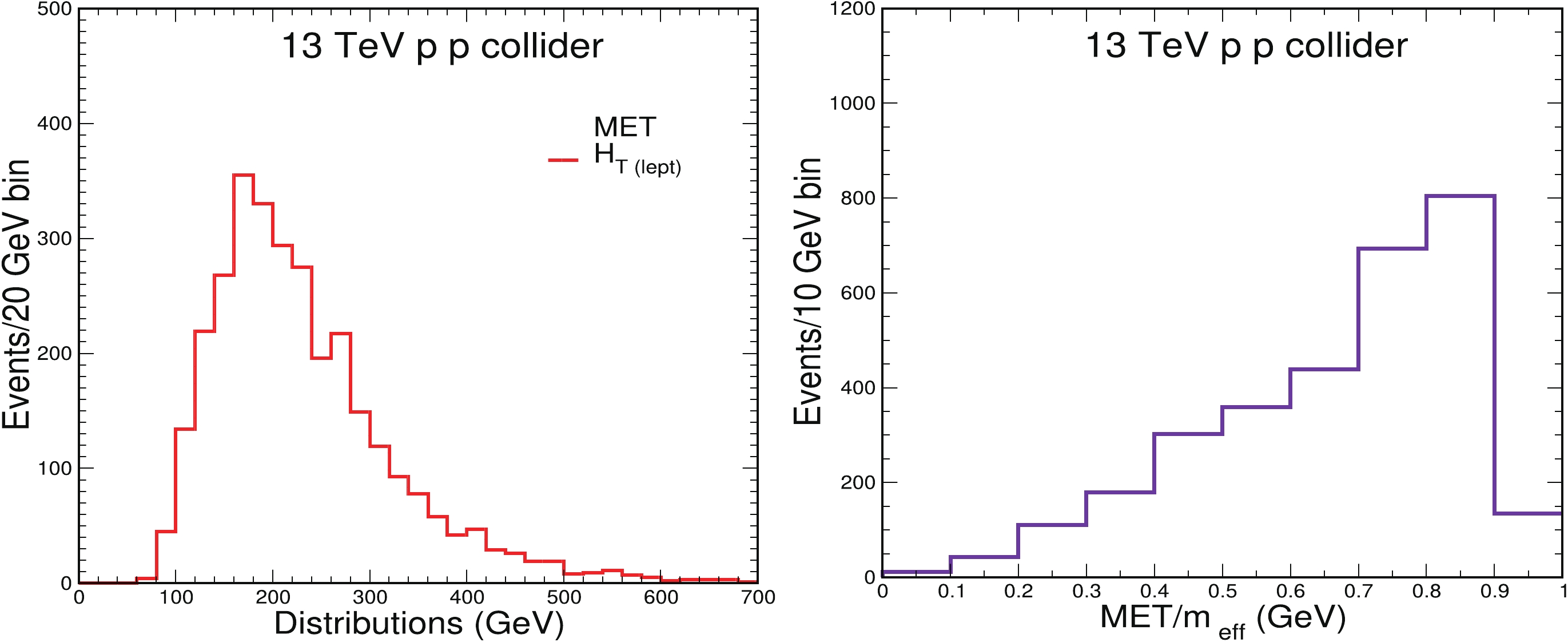
Figure 7. (color online) The transverse missing energy (MET) and sum of all lepton
pT distribution are presented in the left. In the right, the distribution is for the ratio of the MET andmeff . Events are unweighted and generated bypp→Ψ++Ψ−− at 13 TeV p-p collision for BP1.Selection 1:
● Opposite sign same flavor pair of mu and tau (
μ+μ− ) + (τ+τ− ),●
pT(μ1)> 6 GeV,pT(μ2)> 6 GeV,pT(τ1)> 60 GeV,pT(τ2)> 40 GeV,●
|η(μ,τ)|<2.5 ,ΔR(l,l)>0.3 ,Selection2:
● b-jet veto,
MET>100 GeV,HT>150 GeV,●
MET/meff>0.5 ,Selection3:
● Z veto with
MZ±10 GeV.We present the signal cross section after the selections in Table 2 for three BP's. It can be observed that for this multilepton channel, the cross section is well above 1 fb after the selections. The signal does not suffer much from the Z-veto, which is a big advantage for our signal as the Z veto is effective for reducing the backgrounds from Z decays. The b -jet veto and the requirement of the higher ratio of MET and
meff will also be effective to reduce the background for these types of signal. For the discussion on the background of this particular channel, refer to [131]. In general, the multilepton channel possesses less background compared to the other processes. After Selection 3, the number of events at 150 fb−1 is always more than 150 if background is very small, which makes this channel a good candidate look for new physics at 13 TeV LHC run.BP1 BP2 BP3 k33=0.01 

g31≈−0.368 ,

MQ′=1083 

g31≈0.32 ,

MQ′=1200 

g31≈−0.1080 ,

MQ′=1201 

g21≈0.166 ,

ms≈272 

g21≈0.2060 ,

ms≈230 

g21≈−0.6240 ,

ms≈304 

g11≈−0.0468 ,

M≈284 

g11≈−0.0014 ,

M≈250 

g11≈0.0071 ,

M≈320 

Selection 1 3.44 (9.58) fb 2.87 (11.06) fb 2.67 (9.62)fb Selection 2 1.76 (7.31)fb 1.22 (4.88)fb 1.49 (4.36)fb Selection 3 1.63 (5.82)fb 1.06 (3.28)fb 1.38 (4.96)fb Table 2. Signal cross section (fb) after the selections at three different benchmark points at 13 TeV and 27 TeV (italic). Masses are in GeV.
-
We analyzed muon (
g−2 ), LFVs, Z decays,ΔCμ9 for B-anomalies, and M–ˉM mixing in a framework of multi-charged particles, which includes exotic scalars, leptons, and quarks under the localU(1)μ−τ . Owing to the gauge symmetry, we can suppress the LFV process, which could appear from the Yukawa interactions among the exotic lepton, charged scalar, and SM lepton. Accordingly, we found that the sizable Yukawa couplings are naturally allowed to explain muong−2 . First, we formulated phenomenological observables mentioned above in our model and performed numerical analyses to search for allowed parameter sets.Via numerical calculations, we determined that our
ΔCμ9 can accommodate B-anomalies where theZ′ boson contribution is dominant. However, the contribution from the box diagram inΔCμ[box]9 can only reach∼−0.1 when we impose constraints from theZ→νiˉνj invisible decay,Z→μˉμ decay, andBs –ˉBs mixing. This is owing to the stringent constraints fromBs –ˉBs mixing andZ→μˉμ , which restrict the relevant Yukawa coupling constants. We demonstrated that the muong−2 in our model is a sum of the contributions from the scalar boson loop andZ′ loop diagrams. It was inferred that we can explain muong−2 within the2σ level when we include both of these contributions. Finally, we studied the collider physics focusing on the production of doubly charged leptons, using some benchmark points allowed by the numerical analysis. We verified that the channel with pairs of oppositely charged muon and tau has some unique features that distinguish our model signatures from other vector-like lepton signatures at LHC. The exotic vector-like quarks and theZ′ will also provide interesting collider phenomenology; however, we reserve it for a future study. -
This research was supported by the Korean Local Governments - Gyeongsangbuk-do Province and Pohang City (H.O.). H. O. is sincerely grateful to the KIAS member, and log cabin at POSTECH for providing a comfortable space to come up with this project. N.K. acknowledges the support from the Dr. D. S. Kothari Postdoctoral scheme (201819-PH/18-19/0013). N. K. also acknowledges "(9/27-28 @APCTP HQ) APCTP Mini-Workshop - Recent topics on dark matter, neutrino, and their related phenomenologies" where the problem was proposed and also thanks the hospitality of APCTP, Korea.
A multi-charged particle model with local U(1)μ-τ to explain muon g–2, flavor physics, and possible collider signature
- Received Date: 2021-08-16
- Available Online: 2022-04-15
Abstract: We consider a model with multi-charged particles, including vector-like fermions, and a charged scalar under a local






 Abstract
Abstract HTML
HTML Reference
Reference Related
Related PDF
PDF














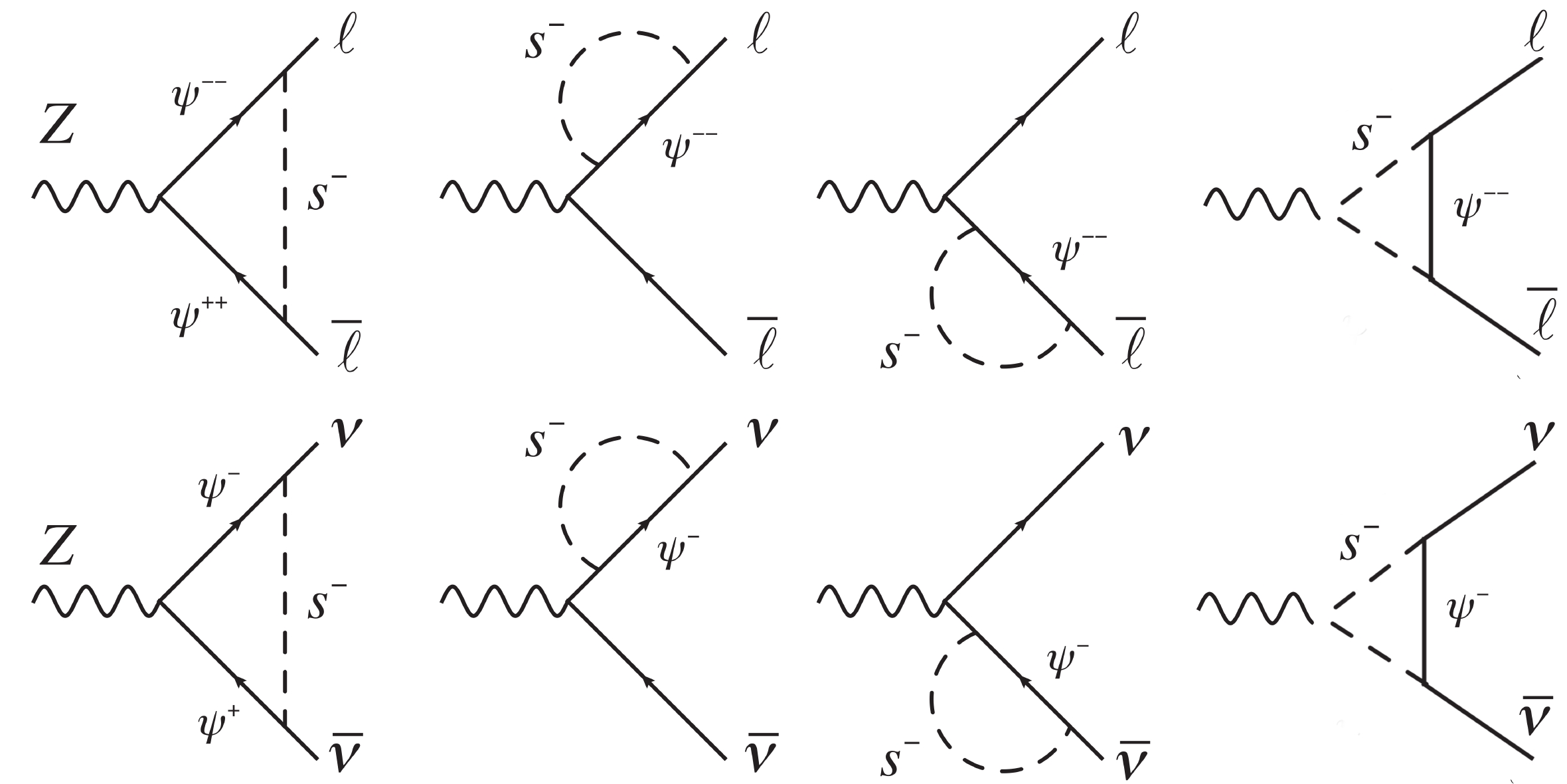



 DownLoad:
DownLoad: